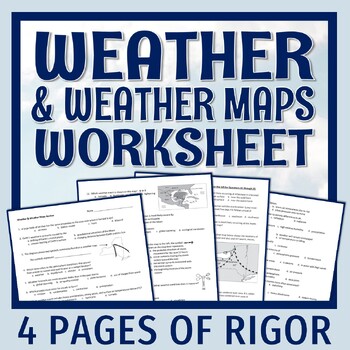NGSS Weather Worksheet Review with Weather Maps Middle School
- PDF
- Easel Activity
What educators are saying
Also included in
- SAVE MORE THAN 35% OFF LIST PRICES! Review and reinforce middle school NGSS weather concepts.Included Worksheets:Weather Review Weather InstrumentsWeather Fronts/MapsRelative HumidityIndividual Descriptions:Weather Review: 4 CONTENT-DENSE PAGES - 42 question standards-based weather worksheet for hPrice $9.99Original Price $15.48Save $5.49
- Never search for "something to do tomorrow" ever again! This bundle contains PRINT AND GO lessons, NO PREP activities, LOW PREP labs, and ENGAGING articles to supplement and thoroughly enhance an Earth and space science course. Every included resource is easy to implement, standards-based, and high-Price $399.99Original Price $649.02Save $249.03
Description
4 CONTENT-DENSE PAGES - 42 question standards-based weather worksheet for homework, test prep, or class review! This worksheet includes weather maps to analyze, prior standardized test questions from various tests, and multiple-choice questions that require a bit more analysis than a typical matching or vocabulary worksheet. Covers NGSS MS-ESS2-5.
⭐Get this worksheet at a huge discount in our Weather Worksheet Bundle!
Topics covered include:
- Reading a weather map
- Cold/warm fronts
- Air pressure
- Weather associated with different fronts/pressure systems
- Basics of convection/wind
Frankly, there's a lot of weather review materials out there, but they just aren't practical for most classrooms. Either they require printing 8+ pages, or they are just too simple for middle school. Our solution was to take the available questions from middle school state standardized tests (and some of our own) and prepare them into one concise, easy-to-print document. We resized, organized, consolidated, and made the document easy to copy and correct.
Teacher Notes:
- 4 pages (2 front/back)
- INCLUDES ANSWER KEY
- Please note: This resource is NOT editable.
- Find the self-correcting Google Forms version of this assignment HERE.
⭐⭐⭐Click here to get 5 FREE EARTH & SPACE SCIENCE lessons!⭐⭐⭐








